Panel 1
Giovanni Finocchiaro, Mariangela Soraci
In 2022, gross fixed investments by industrial enterprises aimed at environmental protection suffered a dramatic collapse: the total value dropped from €1,454.3 million to €508.7 million, marking a contraction of approximately 65% compared to the peak reached just a year earlier. The downturn affected both “end-of-pipe” technologies (−71.5%) and integrated technologies (−47.6%) in a similar manner, so the share of integrated solutions in total investment remained essentially unchanged at just over 40%.
At the sectoral level, manufacturing remained the top investor with almost €300 million, although it reduced its outflows by more than half; electricity and gas lost most of the commitments made in 2021 (−87%), while water management settled at €125 million (−62%). Among CEPA categories, despite steep declines, “Wastewater Management” (€171.7 million) and “Air and Climate Protection” (€126.4 million) remained the most significant.
This indicator measures auxiliary capital expenditure — in terms of gross fixed capital formation — for environmental protection undertaken by industrial enterprises. The statistical unit is the enterprise as an auxiliary producer, i.e. business units that produce environmental services solely for their own use and not for sale on the market.
According to the ATECO 2007 classification (2022 update), the industrial sector strictly defined includes sections ‘B’ (Mining and quarrying), ‘C’ (Manufacturing), ‘D’ (Electricity, gas, steam and air conditioning supply), and ‘E’ (Water supply; sewerage, waste management and remediation activities). Construction companies are thus excluded. This indicator follows the European NACE Rev.2 classification, which also excludes companies engaged in sewerage, waste collection, treatment and disposal, material recovery, remediation, and other waste management services (ATECO divisions 37, 38, and 39).
The international classification CEPA2000 (Classification of Environmental Protection Activities and Expenditure) is the reference standard of the EU regulation for structural statistics and is part of the SERIEE system (Système Européen de Rassemblement de l’Information Economique sur l’Environnement), the satellite environmental accounting framework developed by Eurostat.
Environmental protection expenditure transactions by businesses — i.e. capital investments (not current expenditure) — are presented, where relevant, by individual CEPA class (or groupings), including: 1. Air and climate protection; 2. Wastewater management; 3. Waste management; 4. Soil and groundwater protection; 5. Noise and vibration abatement; 6. Protection of biodiversity and landscape; 7. Radiation protection; 8. Research and development for environmental protection; 9. Other environmental protection activities.
Investment amounts are broken down, where applicable, by technology type:
a) specific machinery and accessories for environmental protection (“end-of-pipe” technologies), and
b) cleaner technology equipment and plants (integrated technologies).
The former refers to investments in pollution control and abatement technologies that act after pollution has been generated (downstream); the latter refers to investments in technologies and equipment that prevent or reduce pollution at the source (upstream and throughout the production process).
The purpose is to assess investments in environmental protection by industrial enterprises and their evolution over time. This information is crucial in evaluating the degree of contribution of the industrial system to environmental safeguarding.
The regulatory framework for collecting environmental protection investment data from industrial enterprises is defined by Regulation (EC) No 295/2008 on structural business statistics, and in terms of satellite accounts, by Regulation (EU) No 691/2011, as amended by Delegated Regulation (EU) 2022/125. The latter reinforced the obligation to distinguish gross fixed investments between “end-of-pipe” and integrated technologies, ensuring data comparability among EU Member States.
Although no binding quantitative targets exist for this indicator, the European strategic framework — notably the Green Deal, the Fit for 55 package, and the Sustainable Finance Strategy — has increased focus on the transparency of environmental investments. In particular, Regulation (EU) 2020/852 on the taxonomy of sustainable activities and Directive (EU) 2022/2464 (Corporate Sustainability Reporting Directive) require companies to report in greater detail the share of spending and investment aligned with the green transition. While not setting sector-specific expenditure targets, these regulatory tools support the development of voluntary benchmarks which could, in the future, lead to quantitative goals or targeted fiscal incentives.
Panel 2
ISTAT, Statistics Report, Various years, Investments by industrial enterprises for environmental protection.
EUROSTAT, Various years, Statistics Explained, Environmental protection expenditure accounts.
With the February 2023 edition, the base data series were revised following the introduction of innovations and improvements in methods and sources. As a result of the revisions introduced, the new series are available starting from 2016 and are not comparable with previous ones.
Moreover, gross fixed investment series are not fully comparable over time because, starting in 2017, the data from surveys that serve as the source for estimates are produced according to a new definition of statistical unit, aimed at ensuring data comparability at the EU level.
Until 2016: 1 enterprise = 1 legal unit.
From 2017: 1 enterprise = multiple legal units.
Interpretive caution: An increase in investments in technologies for environmental protection may indicate an improvement in industrial environmental performance and thus in environmental quality (e.g., pollution reduction); conversely, a decrease does not necessarily imply a net worsening.
-
Data quality assessment
EUROSTAT (Statistical Office of the European Communities), ISTAT (National Institute of Statistics)
I.Stat database at dati.istat.it under the entry:
- Conti nazionali/
- Conti ambientali/
- Spese per la protezione dell’ambiente/
- Investimenti, consumi intermedi e produzione ausiliaria delle società come produttori ausiliari per attività economica (Edizione Feb-2024)
- Spese per la protezione dell’ambiente/
- Conti ambientali/
National
2016-2022
Indicator assessment
The base data are presented as-is or after minimal mathematical processing (e.g., annual percentage trend change).
The year 2022 marks the lowest point in the entire 2016–2022 series (Figure 1).
Total investments, amounting to €508.7 million, reflect a clear predominance of end-of-pipe technologies (Figure 4), which alone account for €302.9 million — around 60% of the total.
Integrated technologies (Figure 5), though also reduced, still play a significant role, amounting to €205.8 million (Table 1).
Manufacturing absorbs the largest share of resources (€299.7 million), followed by water collection and treatment (€125.3 million), and at a greater distance, by electricity and gas supply (€82.1 million), as shown in Figure 3.
In terms of environmental purposes (Figure 2), investments in wastewater treatment and air protection remain priorities, despite a sharp drop compared to 2020 levels (Table 2).
Across the entire time span, three phases can be distinguished (Table 1):
-
The period from 2016 to 2019 shows a slow but steady decline (−21.4%) from the 2016 peak.
-
The following two years, driven by post-pandemic recovery measures, witness an unprecedented rebound: between 2020 and 2021, investments rise by 81%, significantly surpassing the previous record.
-
However, the jump proves short-lived, as in 2022 companies more than halve their commitments, bringing values back to the initial levels of the series and resulting in an overall decline of 61.9% for the full period.
Integrated technologies fell by 57% overall, a drop that is less pronounced than that of end-of-pipe solutions (−64.6%).
Data
Table 1: Environmental protection investments by industrial enterprises, by type of technology
ISPRA elaboration based on ISTAT data
Gross fixed investments in machinery and specific equipment for environmental protection (end-of-pipe technologies) and in cleaner technology equipment and plants (integrated technologies) are aggregated. The total includes all CEPA expenditure classes (1–9). Monetary values are expressed at current prices. The term "industry in the strict sense" refers to industry excluding construction, sewerage management, and waste collection, treatment, and disposal activities. Divisions 37, 38, and 39 of the ATECO 2007 classification are excluded. Starting from the February 2023 edition, the data series have been revised following the introduction of innovations and improvements in methods and sources. As a result of these revisions, the new series are available from 2016 onward and are not comparable with previous editions.
Table 2: Environmental protection investments by industry and its sections
ISPRA elaboration based on ISTAT data
Gross fixed investments in machinery and equipment specifically intended for environmental protection (end-of-pipe technologies) and in cleaner technology equipment and plants (integrated technologies) are aggregated. The total refers to all CEPA expenditure categories (1–9). Monetary values are expressed at current prices. Divisions 37, 38, and 39 of the ATECO 2007 classification are excluded from the definition of industry in the strict sense. With the February 2023 edition, the data series were revised following the introduction of methodological improvements and innovations in data sources. As a result of these revisions, the new series are available from 2016 onward and are not comparable with previous editions.
Table 3: Environmental protection investments by industry, its sections, subsections, and divisions, by type of technology and CEPA category
ISPRA elaboration based on ISTAT data
Gross fixed investments in machinery and specific equipment for environmental protection (end-of-pipe technologies) and in cleaner technology equipment and plants (integrated technologies) are accounted for. The sum of all CEPA expenditure categories (1–9) is provided. Monetary values are expressed at current prices. Divisions 37, 38, and 39 of the ATECO 2007 classification are excluded. With the February 2023 edition, the data series have been revised following the introduction of innovations and improvements in methods and sources. As a result of these revisions, the new series are available from 2016 onward and are not comparable with previous editions. For the series "manufacture of chemical products" and "manufacture of other non-metallic mineral products," data are available only up to 2019 (February 2022 edition), and CEPA expenditure classes from 4 to 9 are grouped.
Table 4: Environmental protection investments, selected divisions of the manufacturing industry
ISPRA elaboration based on ISTAT data
nd "non disponibile"; na "non applicabile"
Gross fixed investments in machinery and specific equipment for environmental protection (end-of-pipe technologies) and in cleaner technology equipment and plants (integrated technologies) are aggregated. The total for all CEPA expenditure categories (1–9) is presented. Monetary values are expressed at current prices. Divisions 37, 38, and 39 of the ATECO 2007 classification are excluded from the definition of industry in the strict sense. With the February 2023 edition, the data series have been revised following the introduction of innovations and improvements in methods and sources. As a result of these revisions, the new series are available from 2016 onward and are not comparable with previous editions. For the "manufacture of chemicals" and "manufacture of non-metallic mineral products" series, the available data are up to 2019 (February 2022 edition).
Table 5: Environmental protection investments by industrial enterprises, by CEPA category
ISPRA elaboration based on ISTAT data
Gross fixed investments and acquisitions less disposals of non-financial non-produced assets are reported, including investments in machinery and specific equipment for environmental protection (end-of-pipe technologies) and in cleaner technology equipment and plants (integrated technologies). Monetary values are expressed at current prices. Divisions 37, 38, and 39 of the ATECO 2007 classification are excluded from the definition of industry in the strict sense.
Figure 1: Environmental protection investments by industrial enterprises, by technology type (M€, 2016-2021)
ISPRA elaboration based on ISTAT data
Gross fixed investments in machinery and specific equipment for environmental protection (end-of-pipe technologies) and in cleaner technology equipment and plants (integrated technologies) are reported. The total for all CEPA expenditure categories (1–9) is provided. Monetary values are expressed at current prices. Divisions 37, 38, and 39 of the ATECO 2007 classification are excluded from the definition of industry in the strict sense.
Figure 2: Environmental protection investments by industrial enterprises, by CEPA category (M€, 2016-2021)
ISPRA elaboration based on ISTAT data
Gross fixed investments and acquisitions less disposals of non-financial non-produced assets are reported, including investments in machinery and specific equipment for environmental protection (end-of-pipe technologies) and in cleaner technology equipment and plants (integrated technologies). Monetary values are expressed at current prices. Divisions 37, 38, and 39 of the ATECO 2007 classification are excluded from the definition of industry in the strict sense.
Figure 3: Environmental protection investments by industrial activity section (M€, 2016-2021)
ISPRA elaboration based on ISTAT data
Gross fixed investments and acquisitions less disposals of non-financial non-produced assets are reported, including investments in machinery and specific equipment for environmental protection (end-of-pipe technologies) and in cleaner technology equipment and plants (integrated technologies). Monetary values are expressed at current prices.
Figure 4: Composition of end-of-pipe technology investments for environmental protection, industrial enterprises, by CEPA category (M€, 2021)
ISPRA elaboration based on ISTAT data
Gross fixed investments in machinery and specific equipment for environmental protection (end-of-pipe technologies) are accounted for. Monetary values are expressed at current prices. Divisions 37, 38, and 39 of the ATECO 2007 classification are excluded from the definition of industry in the strict sense.
Figure 5: Composition of integrated technology investments for environmental protection, industrial enterprises, by CEPA category (M€, 2021)
ISPRA elaboration based on ISTAT data
Gross fixed investments in cleaner technology equipment and plants (integrated technologies) are accounted for. Monetary values are expressed at current prices. Divisions 37, 38, and 39 of the ATECO 2007 classification are excluded from the definition of industry in the strict sense.
Figure 6: Environmental protection investments, selected divisions of the manufacturing industry (M€, 2016-2021)
ISPRA elaboration based on ISPRA data
The inner ring represents 2019, while the outer ring represents 2020.
Gross fixed investments in machinery and specific equipment for environmental protection (end-of-pipe technologies) and in cleaner technology equipment and plants (integrated technologies) are accounted for. The total for all CEPA expenditure categories (1-9) is presented. Monetary values are expressed at current prices. For the series "manufacture of chemicals" and "manufacture of non-metallic mineral products," the available data are up to 2019 (February 2022 edition).
Figure 7: Environmental protection investments by industrial enterprises, by CEPA category (M€, total from 2016 to 2021)
ISPRA elaboration based on ISTAT data
Gross fixed investments and acquisitions less disposals of non-financial non-produced assets are reported, including investments in machinery and specific equipment for environmental protection (end-of-pipe technologies) and in cleaner technology equipment and plants (integrated technologies). Investments for all years from 2016 to 2021 are summed. Monetary values are expressed at current prices. Divisions 37, 38, and 39 of the ATECO 2007 classification are excluded from the definition of industry in the strict sense.
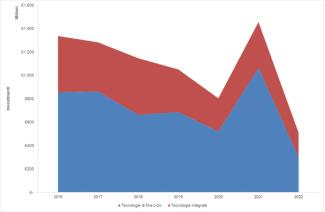

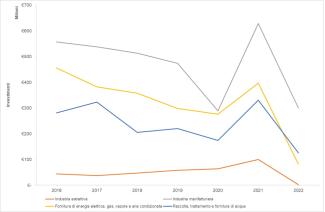

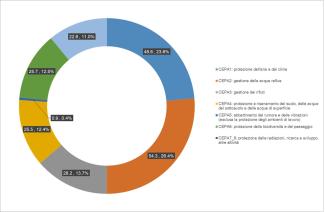
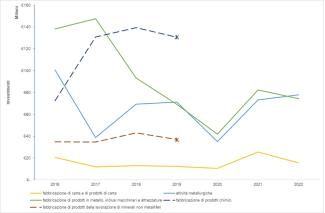
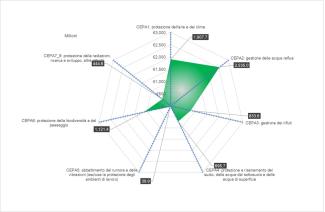
The recent dynamics of industrial environmental investments reflect high cyclicality: the total value drops from €1,454.3 million to €508.7 million, corresponding to a 65 percent decrease (Table 1). The decline is widespread across economic sectors but is particularly pronounced in the supply of electricity and gas, which loses 87 percent of flows in twelve months, while manufacturing reduces its amounts by about half, yet remains the leading investor (Figure 3).
The technological profile remains skewed toward end-of-pipe solutions: these absorb €302.9 million, corresponding to 59.5 percent of the total, compared to €205.8 million allocated to integrated technologies (Figure 1). In terms of environmental purposes, wastewater treatment accounts for €171.7 million, followed by air and climate protection with €126.4 million, both items showing a strong contraction compared to 2020 (Figure 2).
The medium-term outlook highlights divergent trends: between 2016 and 2022, investments aimed at waste management increased by over 40 percent, while those directed towards biodiversity and landscape decreased by more than 80 percent (Figure 7). Overall, the prevalence of “downstream” interventions compared to integrated preventive solutions highlights the need for stable incentives and a reliable regulatory framework to support a more consistent investment trajectory focused on prevention.